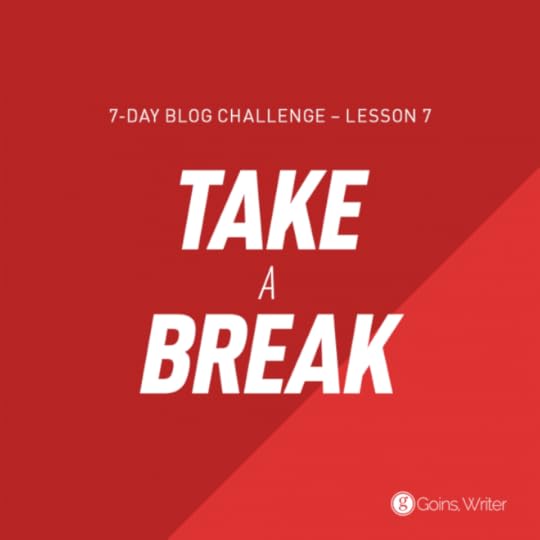Jeff Goins's Blog, page 42
March 20, 2016
Blog Like a Pro Lesson 7: Take a Break
Claude Debussy has been credited for saying music is the space between the notes. The same is true for writing. Good writing is all about space.
This past week, we’ve been doing a very intense 7-day blogging challenge. Thousands of people have participated. It’s been a lot of fun, and honestly, a challenge for me, too.
I used to blog every day. But as life got busier and the Internet grew noisier, I stopped doing that. This week stretched me because I went back to publishing 500-word articles every day. That’s a tough frequency to keep up with. Some mornings I was writing that day’s challenge over breakfast.
A sprint, not a marathon
So today, I want you to take a break. Step back and appreciate all you’ve done this week, whatever it is. And remember that writing is not a sprint, but a marathon.
Currently I’m training for a half marathon race at the end of April. And as part of my training, I’m supposed to occasionally run sprints. I hate sprints. They make me want to throw up. But I recognize the value of sprinting. Sprints make you run faster. They complement the long, hard slog of regular running.
The same is true for your blog. If you want to build a community, it will take time. And often the work will look pretty monotonous. You’ll get up early or stay up late and just barely squeeze the writing in. But you will get it done. And if you keep up this habit, you will create something significant.
This challenge was a sprint. It was meant to kick start some new habits for you and help you grow. Now, the marathon begins.
Take time to reflect
So today, I want you to reflect back on this week. What did you learn? How did you grow?
Celebrate your wins. Learn from your mistakes. And no matter what, don’t forget to keep going.
Assignment: Look back on all you’ve accomplished. Finish anything you didn’t get to. Then celebrate! Share your experience and what you accomplished in the comments. I want to hear it. Remember, one lucky winner will get a $5000 coaching package with me. To enter, you MUST leave a comment on this post, sharing everything you accomplished and what you learned. I’ll choose the winner by noon CST on Monday.

March 19, 2016
Blog Like a Pro Lesson 6: Ask People to Share
So at this point, you may be wondering: where is everyone? Where all the readers, the visitors, the fans of your blog? You’re doing all these things to improve your blog, but nobody’s showing up. What’re you doing wrong?
You want more readers? Want more fans? You really, really do? Well, it comes down to one simple tactic that many bloggers neglect: you have to ask.
You have not, because you ask not.
The art of the bold ask
Look. There’s a time to give, and there’s a time to ask. And you’ll never get to pro status as a blogger if you don’t eventually put your work out there and ask people to not only engage in it but share.
The trick here, as we observed yesterday, is to give more than you try to take. But there’s absolutely nothing wrong with occasionally making a plea for some readers. Time and time again, I’m amazed at the power of asking when it’s preceded by a season of giving.
Here’s a recent example.
A friend and I went out to lunch the other day. While at lunch, my friend gave me a copy of Gary Vaynerchuk’s new book, #AskGaryVee.
“Oh, thanks,” I said. “I’ve been meaning to get this.”
“Yeah,” he said. “I bought nine copies.”
“Nine copies?!” I said. Of a $25 book?! That’s no small thing.
“Yep.”
“Why?”
“Because, look. I have watched every episode of Gary’s free YouTube show. And he has not asked for a single thing in these past two years… except to buy his book. So I bought nine copies and gave them to friends.”
Wow. That’s the power of two things:
First, you have to give your way into influence (we talked about this yesterday).
And second, you can’t complain that nobody is listening to you or buying your books or paying attention to you if you don’t occasionally ask your audience to care about the things that you care about.
You can’t do this all the time. But every once in a while, a well-placed ask is powerful.
I realized this years ago when I started meeting influential people and saw that how, over time (i.e. the course of months), when I would ask them for things, they would almost always say yes.
You have not, because you ask not.
So be generous. And then be bold. And be okay with when they say no.
A final warning
One word of caution on this: don’t be the guy or gal who’s constantly running around asking people for favors. That is not what I am saying here. At the same time, don’t go broke or neglect your blog because you’re afraid of a little rejection.
If you ask, you’re going to get rejected. Eventually. So just get used to it.
But if you serve first, and ask later, and you don’t hold it against people when they turn you down, you will be surprised at the kind of favor you receive.
Maybe you’ll be awed (like I was) to see that sometimes when you put an important piece of work out there, like a book or a conference or a blog, there will be a long line of people waiting to help you make this thing succeed.
But you’ll never know if you don’t ask.

Assignment: Ask people to share your blog. Write something useful or helpful or use something you’ve already written and then personally ask 10 people to share it online. They can tweet or Facebook or email or link to it or all of the above. Ask a few people you know will say yes but then a few you would love to share your work but are secretly afraid to ask.
And here’s the thing: don’t tell them what’s in it for you. They know that part. Tell them what’s in it for them and why this piece is perfect for their audience. Make it relevant to them, ask nicely without any coercion or manipulation, and be gracious if they say no (and incredibly grateful if they say yes).
Then reach out and try to do the same for someone else. Remember to pay it forward. Leave a comment here once you’ve completed the assignment.
Speaking of which, could you share this post?
Thank you!

March 18, 2016
Blog Like a Pro Lesson 5: Be Generous
While I was growing up, my dad used to say to me, “what goes around, comes around.” It took me 20 years but I’ve finally learned the truth of those words.
It wasn’t until I began trying to write full-time that I realized how important relationships were — to everything. Every job I’ve had, every lucky break I’ve received, can all be attributed to relationships.
Give and take
As you probably know, all healthy relationships are two-sided, built on a system of giving and taking. But the people who ultimately end up winning in life are the ones who give more than they take.
Adam Grant wrote about this in his book, Give and Take, in which he shared that the world’s most successful people were givers. But he also noted that the world’s least successful people were givers, too.
So what does it take to be the right kind of giver? The kind that isn’t a doormat or a pushover?
You have to be strategically generous, according to Grant, giving in ways that can create a network of people who will continue to pay you goodwill so that everyone benefits. This doesn’t mean you only help the people who can help you or that you use your generosity for selfish gain. But it does mean that your time is limited. So where you invest it better count.
Strategic generosity in action
Here’s how I apply this: in all things, including blogging, I try to give more than I take, offer more than I ask, and share what I learn along the way.
One thing I’ve learned with a blog is the community is contingent on generosity. You can’t build a tribe of dedicated followers without a spirit of giving guiding it. Otherwise, people will assume you’re only out for your own gain. And nobody will trust someone they know to be selfish.
So here’s what you do. You want an audience for your words? You want a popular blog? You need to give your way into influence. Before they make it about you, you will have to make it about them.
Developing a generous mindset
The exercise today is quite simple. You must give something of value away to your audience. This is the best way to build trust and even earn the attention of a larger audience. We all implicitly trust those who want to give more than take. So be that kind of person. In the end, you’ll learn what goes around does indeed come around.
By the way if enjoyed yesterday’s challenge to guest post, you’ll love this free eBook on writing guest posts. Download it here.
And since I believe in putting my money where my mouth is, I’ll be doing a giveaway myself. Read the challenge below to find out more.
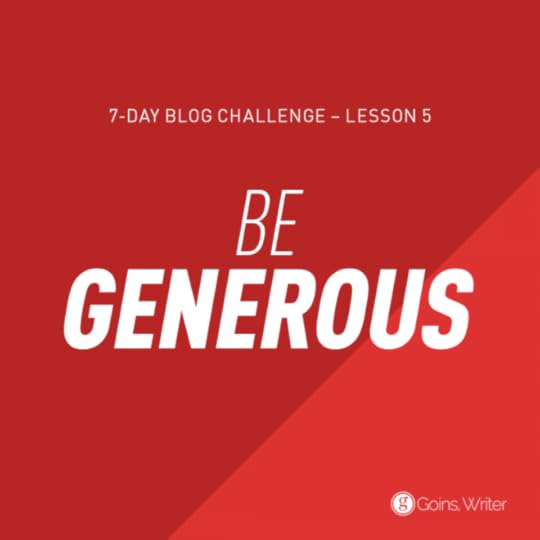
Assignment: Find something you can give away on your blog. Use a plugin like Rafflecopter, or keep it low tech and just let people enter by leaving a comment. Once you do this, drop a comment here and you’ll be entered to win a year’s subscription to SumoMe Pro, the tool I use to grow my blog. I’ll pick one lucky winner in the next 24 hours.
What will you be giving away? Share in the comments.

March 17, 2016
Blog Like a Pro Lesson 4: Spread Your Message Like St. Patrick
Now that you’ve got a blog, a lead magnet and know what you’re about — now that you know how to pick a fight — what do you need? You need to evangelize.
Today is St. Patrick’s Day and as a proud Irish American, I love this holiday. Why? Because it shows the power of one person’s words.
Patrick was a slave who escaped from Ireland, later became a Christian, and returned to the place of his captivity to be one of the world’s first and most influential missionaries.
What was remarkable about his mission is that unlike many other religious conquests and crusades, his evangelism was entirely peaceful. Ireland became a Christian nation without any bloodshed, in spite of it being a barbarous land at the time. That’s the power of words.
But what good is a message if you don’t share it?
Spread your words to the world
Your mission today is to be like St. Patrick. Go to new lands and spread the good news. And in the world of blogging, that means guest posting.
The best way to get free, qualified traffic is through guest posting. What is it, exactly? Guest posting is free advertising for your blog. It’s you posting your content on someone else’s blog with their permission. And it works really well.
This is how I got my first 10,000 subscribers — through guest posting. Here’s how it works:
Identify a blog you want to write for.
Read and study the blog until you find a gap in the content you could fill.
Build a relationship with the author and ask to contribute a guest post.
Here’s the secret to success with this. When you add more value than you take, people will say yes. Approach this with an attitude of servanthood and you will have better luck than the Irish.
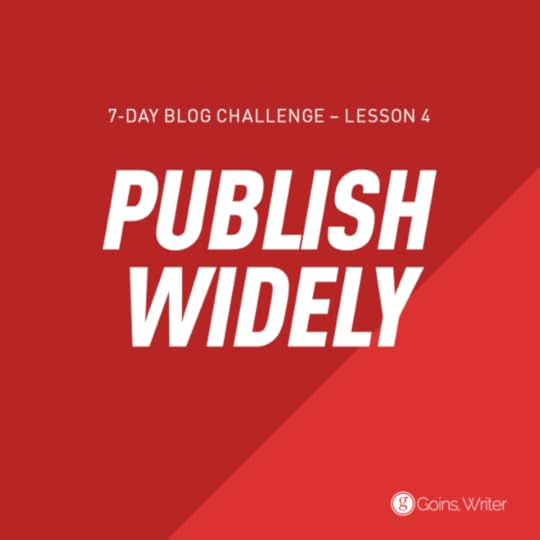
Assignment: Find someone to guest post for. Or publish something on Medium.com. Share it in the comments.

March 16, 2016
Blog Like a Pro Lesson 3: The Fastest Way to Get Attention Online
Why do certain political candidates succeed when they criticize other certain political candidates? Because controversy sells. And if you don’t think this has any bearing on your writing, you’re kidding yourself.
People want to believe they’re in an epic battle of good versus evil. But we all know real life is filled with much more nuance and gray area than we’d like. Or do we? In politics and and life, we want a good guy and a bad guy. We want a story to follow that is simple and easy to understand, and we want to know who to root for. More than anything, we want to believe we are engaged in an important struggle and that our side is going to win.
Of course, you can use this manipulate people and coerce them into doing things they wouldn’t normally do if they were thinking rationally. You can use these ideas to grab power and corrupt the masses, if you’d like. I wouldn’t recommend that, but you could do that if you really wanted.
On the other hand, you can’t ignore these rules.
Pick a fight
What grabs people’s attention is conflict. This is true in story, and this is true life. And nowhere is that more important than in writing. You have to have an argument, something to say that people will disagree with. I mentioned this in a Facebook group the other day, and a person told me I should use a less aggressive word like “perspective.” But that’s not what I meant. I meant argument.
Look. You don’t have to be argumentative to have an argument. But you do have to have something to say. And it begins with disagreement. What’s something wrong with the world that you could fix? What’s a problem you know the answer to? How do you feel about X (insert your political, moral, or religious issue)? We all have opinions about certain things, and we don’t do them any justice by keeping quiet.
Make it interesting
I maintain there is a thoughtful way to share your opinion with the world in a way that doesn’t sound like empty rhetoric or hyperbole. It simply comes down to making a case for your belief and taking a stand behind it. And here’s the truth: you don’t have to be right to be interesting. But just because you happen to be right doesn’t mean people will think you’re interesting.
What makes for interesting and engaging content – on a blog, in a movie, or even in politics – is when you have someone who says, “This is WRONG. Who’s with me?” In many ways, identifying what you’re against is more attractive that stating what you’re for. It’s crazy, I know. But it’s the way our minds seem to work.
One law you can’t ignore
So what does this have to do with writing and your blog? Good question. Everything. The truth is we are attracted to ideas that grab us. We want to be part of movements that mean something. And that means you can’t just be vanilla. You can’t be so-so. You have to be big and audacious and that can look a million different ways. You have to pick a fight.
Does this mean you have to be pushy and angry and call people names? Of course not. But it does mean you have to lean in to the argument you want to make. Now, don’t be contentious for the sake of contentiousness. But at the same time, you can’t ignore this law of curiosity. People are fascinated with a fight. And every piece of writing contains a little argument worth sharing.
So the next time you sit down to write, try the following prompts to get started:
Everyone thinks [BLANK] but here’s what’s actually true…
The ugly truth about [BLANK]
Why everyone says [BLANK] but really you should [BLANK]
What it really takes to [BLANK]
The myth about [BLANK]
And so on. Surprise people. Incite them. Get them excited about a battle worth fighting. Don’t attack a person. Attack a bad idea or an injustice or something that’s just plain broken. Then paint a picture of how things can be better; give your reader hope and invite them into that solution.
That’s something that writing, perhaps, does better than politics.
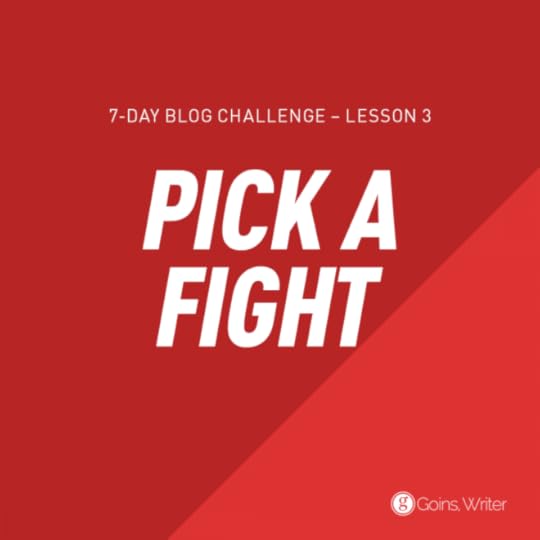
Assignment: Find something other people are saying and disagree with it. Don’t do it just to be controversial. Do it because you actually disagree with it. Write about a belief or idea people tend to take for granted. And then obliterate it. Invite people into the discussion and see how they respond. Be careful, though. This can get heated. You’re dealing with the most powerful form of communication there is. Good luck. Then share a link to your piece below.
What do you think of controversial writing? What’s your fight to pick? Share in the comments (along with a link to your piece!).

March 15, 2016
Blog Like a Pro Lesson 2: Make Your Blog Matter (to Others)
It’s one thing to write. It’s another to connect. Great writers understand implicitly the goal of writing is not just self expression. It’s connection.

How do you know you’re doing your job as a writer? How do you know you have an effective blog?
Simple: you know because you’re connecting with readers. You’re getting feedback, people telling you that your work matters — to them.
Getting practical
How do you do this?
You build an email list. Forget what you’ve heard about email marketing and how people say it’s dead. It’s not. Email marketing is very much alive. In fact, email is the most universal way to communicate with most people online.
So how are you asking for people’s email addresses on your website? This is important. If you don’t ask people for permission to continue communicating with them after they’ve left your website, you’re leaving a lot on the table.
What does this take? How do you get people’s email addresses? You need an incentive for people.
Call it a lead magnet or an ethical bribe or whatever you like. I like to think of it as a reward for people’s attention. Whatever name you use, the point is to give people a reason to sign up for your email list and to give you an opportunity to stay in touch with them the next time you have something to say.
But where do you begin? By creating something brand new out of nothing? Not necessarily. The most effective lead magnets tend to come from existing content. So here’s what you should do:
Repurpose an existing piece of content — a popular blog post, your recent manifesto from yesterday’s assignment, or something else — and turn it into a lead magnet. Edit it and then turn it into a short PDF eBook.
Sign up for an email marketing service like Aweber or Mailchimp and set up a new email list to deliver your free lead magnet.
Start collecting email addresses. Use a tool like SumoMe (which is free!) to create a pop-up to deliver your free lead magnet. This is way easier than having to embed complicated code on your website. Watch this video to see how to get started.
The goal of this assignment is simple: you’re trying to connect with people. You want feedback so that you can get an idea of how your work is making a difference in people’s lives. We don’t find our voices writing for ourselves. We find our voice when we hear it resonating with others.
You have to put your work out there. And you have to give people an opportunity to respond. That’s what today is about: building an asset that will be the bedrock for how you communicate with your audience from here on out.
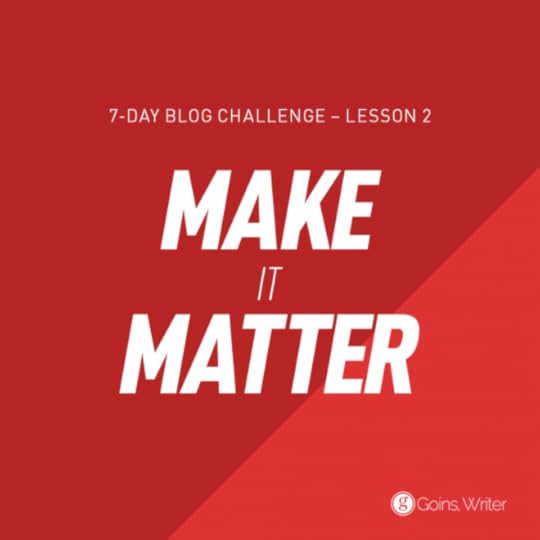
Assignment: Take yesterday’s manifesto and turn it into a lead magnet. Once you have that set up (if you already have one, use this as an opportunity to create something new), share it here. The person who collects the most emails by 7:00 a.m. CT, Mar. 16 will win a free copy of Bryan Harris’s Get 10,000 Subscribers course.
Do you have a lead magnet? Share the link in the comments of this post (then update us again tomorrow with the number of new subscribers you got through this assignment). I’ll announce the winner in tomorrow’s challenge.

March 14, 2016
Blog Like a Pro Lesson 1: Know What You’re About
All great writing is about something bigger than the author. When you set out to build a community, you have to create something that’s bigger than you. And before you can do that, you have to know what you are all about.
What’s your worldview? What gets under your skin? What wrecks you?
These are the questions great writers, and incidentally great bloggers, must ask themselves. The answer can something big and bold like women’s rights issues or something fun like dog sweaters. It doesn’t have to be serious to be important. And once you’ve identified it, that thing you’re writing about, you’ve created something powerful for your readers to connect with.
By the way, this is not a subject I’m talking about. It’s bigger than that. An overarching theme to every word you write, everything you have to say. In writing, the why should always be bigger than the what.
Where we begin
So where do you begin? Start here: with a manifesto.
A manifesto is a short, shareable document that makes an argument, that tells the world what you’re about. It’s something that picks a fight, makes a stand, gets people to stand up and say “yes I agree with this” or “no way!”.
The point of a manifesto is that it makes you draw a line in the sand, which forces you to clarify your message. But before you do that, you have to know what you’re about. Right?
So let’s clarify what you have to say.
The power of clarity
Just how powerful is a manifesto? Well, here are a few examples:
The Declaration of Independence, which initiated America’s fight for independence, is a manifesto. It’s incredibly short (a single-paged, handwritten letter). But there’s a lot of power packed in that brevity.
Martin Luther’s 95 Theses, which sparked the Protestant Reformation and changed the face of one of the world’s largest religions forever, was also a manifesto. It was a list of grievances Luther had with the Catholic Church. Sometimes, complaining can be the way that leads to change.
The Communist Manifesto written by Karl Marx was nothing more than a pamphlet about inequality amongst the world’s workers, and yet it sparked a global revolution. When you use words to tap into what people are feeling deep down inside, you have unmatched power to lead and motivate others to action.
As you can see, words move people. That part is hard to contest. But be careful with this power. You need to point it in the right direction. Otherwise, you’re playing with fire.
So what kind of movement will your words create? Begin by focusing your message on what you’re about and why it matters. That’s where all great writing starts and where all important movements start.
The best way I know how to do that is to write a manifesto. Just draft a few hundred words answering the following questions:
What’s the problem? This can be with the government, the world, or some niche hobby.
What’s the solution? What do you propose we do to fix this problem?
What’s the next step? What is the one call-to-action you want to leave people with? Tell me them to do that one thing.
For an example of a manifesto, which is only 900 words and has been inspiring hundreds of thousands of people for years, you can read mine here.
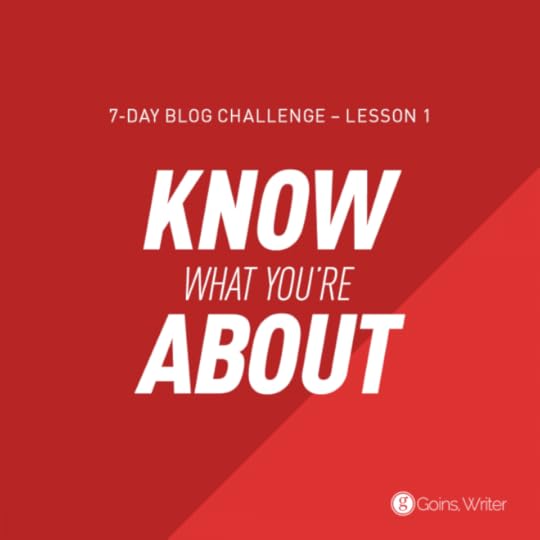
Assignment: Write a manifesto: a 500-word treatise on what you’re about. Then publish it and share it in the comments.

March 13, 2016
How to Launch Your Blog Like a Pro
This week, we’re running the Blog Like a Pro Challenge, and you’re going to want to be a part of it.

What does this entail? 7 days. 7 blog posts. 1 epic challenge that will leave you a better blogger. But before you jump in, you’d better have a blog. So let’s talk about that.
Why do you need a blog?
Three important reasons:
Because blogging is accessible. Anyone can do it.
Because blogging is relatively easy once you understand the tools, which I argue even your grandma can figure out.
And lastly because blogging is powerful. It’s a simple way to get your words out into the world. If you have something to say, why wouldn’t you have a blog?
But lots of people launch blogs that never make an impact. How will yours be different? Well, there are a few things that I think set a professional blog apart from the rest of the clutter on the Internet:
First, a professional blog is owned by the author. In other words, it’s self-hosted, which really means that you pay to host the website elsewhere as opposed to letting a free service like WordPress.com or Blogger host it. There’s nothing wrong with those services, except that they can put up ads or any kind of other distractions on your website whenever they like. Why gamble by placing the controls to your content in someone else’s hands? Own your words.
Second, a professional blog is branded well. What I mean by that is you should be using a .com or .org version of your domain name if at all possible (the domain name is the web address people will use to get to your site). A good domain name should be short, memorable, and relevant to the blogger’s message. In other words, dancing-girl-1352.net doesn’t work. Find a good domain name and use it.
Third, a professional blog is designed well. This is why I recommend WordPress. It’s free to download, cheap to host on any number of sites (like Bluehost, for example, which I have an affiliate relationship with and love recommending), and has a ton of free resources including a treasure trove of nice-looking free themes. What makes a theme design a winner? Clean layout, simple graphics, and nothing that distracts the readers from the copy. Invest in the design of your site, and you won’t regret it.
Ready to start blogging?
Okay, so now that I’ve made my case, here’s what you need to do:
Set up your blog. I recommend a self-hosted solution like Bluehost (watch the 8-minute video below to get set up). For less than $4/month, you can get rolling with your very own, customized website. Pretty amazing, right?
Choose a domain name that matches your brand and message. It could just be your name, the subject about which you’ll be blogging, or some kind of mashup of the two (for example, my name is Jeff Goins and I’m a writer, so I chose Goinswriter.com).
Install a WordPress theme. These range from free to fairly expensive (a few hundred dollars). I recommend something simple to begin with like the Twenty Sixteen Theme, which doesn’t cost a thing. You can always upgrade later.
Start blogging! The first thing you want to write is your about page, because that’s one of the most important pages on your website that many bloggers ignore.
If you get stuck, there are tutorials for all this stuff (Google is your friend). But keep in mind, that’s why we’ve built this community of bloggers — so that you can get the help you need. If you need something, just pop into the Intentional Blogging Facebook group and ask your question. I’m sure someone will help you.
And if you don’t have a self-hosted blog, I highly recommend getting one. You can follow my quick tutorial here. Or watch the video below.
So that’s all for today. Get started blogging and make sure you’re signed up for the daily email updates on the challenge if you don’t want to miss a thing. A week goes by pretty fast!
Assignment: Set up your blog. Share the link in the comments.

March 11, 2016
Blog Like a Pro: 7-Day Challenge
Ever wondered what it takes to get your message heard as a writer? So many people start in the wrong place. I’m hosting a free challenge to change that. For seven days, I’m going to give you a daily challenge on how to take your blog to the next level.
Once in a while, I reach out to the Internet and encourage anyone who’s ever thought of blogging or maybe started a blog but haven’t seen it take off in the direction they wanted to join me in a blogging challenge.
And we’re doing that again, right now. Here are the details:
When does this start?
Now. Right now. Why stall or hesitate? Set up your blog (it takes eight minutes!), and get going. The best time to get your words out there was yesterday. The second best time is today. (Technical dates of the challenge are: Mar. 14-21).
Who is this for?
Anyone who: a) has a blog and wants to take it to the next level, b) had a blog but have since stopped posting to it, or c) has always wanted to blog but just never got started. Whoever you are, we’d love to have you! (If you need help with the technical side of blogging, go ahead and join, and we’ll help you with that, too.)
Why now?
Because you can always get better. And this is free. So that’s a hard price to beat. Oh, and I’ll be picking ONE person who completes all the assignments to my satisfaction and will be personally coaching them. Which is worth, like, a ton of money. 
March 9, 2016
097: From Money Saving Mom to Money Making Mom (and Beyond): Interview with Crystal Paine [Podcast]
The average American household has over $15,000 in credit card debt. However, some people don’t have a spending problem. They’re great at cutting coupons and keeping costs low, but saving money only goes so far. At some point you need to address the income problem because you can’t save money if you don’t make money.
With the rising cost of raising a family, many homemakers dabble in blogging and online business to make ends meet. Fueled by a desire to get out of debt and leave a financial legacy for their children, stay-at-home moms (and dads) start websites dedicated to one topic or another in hopes of earning a side income.
Crystal Paine started a “mommy blog” to help her young family become debt-free while her husband was still in law school. After two-and-a-half years of writing online, she pivoted her platform and launched Money Saving Mom in response to requests from her readers for more content about saving money on household items.
Fast forward ten years and Crystal’s audience has grown beyond two million fans. She’s helped dozens and dozens of women start online businesses of their own and learned plenty of hard lessons about making money.
This week on The Portfolio Life, Crystal and I talk about how a plan creates focus for your work, and why everyone sets goals a little differently. Listen in as we discuss the challenges of making money online while still trying to be a good spouse and parent.
Listen to the podcast
To listen to the show, click the player below (If you are reading this via email or RSS, please click here).
You cannot flee failure
It’s more embarrassing to fail once you’ve succeeded a little bit.
We might wax philosophical about past failures, but most of us would rather avoid the pain of future mistakes. Last year, after enduring a business failure, I got depressed and was tempted to pull the plug on everything I’d built.
My therapist asked what I learned from the experience and I told him that I never wanted to be in that situation again.
He asked, ”How are you going to do that? Did you have enough information to not put yourself in that situation before?”
“No”, I replied.
“With the information you have now, you wouldn’t go back and do it again?”
“No.”
“Then you did the best with the information that you had, you survived, and you learned from it.”
When we think about trying something new, the sting of past failures can cripple us with fear. The best thing we can do with failure is learn from it and apply the lessons to our next attempt.
Crystal made a mistake that significantly hurt the bottom line of her business. She looked before she leaped and still failed miserably. Now, even though the trajectory of her business has changed, Crystal grew personally from the experience, and learned a lot professionally from the failure.
Just because you’ve won before doesn’t guarantee you’ll win again, but you’ll never know unless you try.
Show highlights
In this episode, Crystal and I discuss:
Why homemakers should consider online business
Motivations for starting to monetize a blog
Listening to your audience to understand what they need from you
How to leverage current events to gain momentum
Building on failure to ultimately achieve success
Rules for sharing family stories online
Which blogging platform to use
Diversifying income streams
Why understanding your “why” is the most important step in setting goals
Quotes and takeaways
“You make time for what’s a priority to you. If it’s not a priority, you’re going to make an excuse.” —Crystal Paine
Saving money and making money are two sides of the same coin. You have to make money to save money.
“Give yourself permission to make mistakes.” —Crystal Paine
Failure is a hard pill to swallow, but it helps you grow.
“We are created to be a community, not competitors.” —Crystal Paine
Avoid the comparison trap by celebrating other people.
Resources
Money Making Mom by Crystal Paine
MoneySavingMom.com
Do you struggle with contentment and comparison? How are you preparing for success by establishing a strategy? Share in the comments



